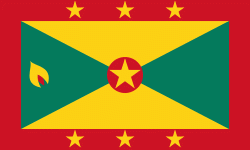Flag of Grenada
The flag of Grenada consists of two yellow triangles at the top and bottom and two green triangles at the hoist and fly. These are surrounded by a red border charged with six five-pointed yellow stars – three at the top centre and three at the bottom centre – along with an additional star on a red disc at the centre and a nutmeg at the hoist triangle. Adopted in 1974 to replace the temporary design used since the islands became an Associated State of the United Kingdom, it has been the flag of Grenada since the country gained independence that year. The representation of a nutmeg is symbolic of the islands' primary export, and was the one feature from the previous flag that was preserved.
Sovereignty over Grenada changed hands between the French and the British throughout the 18th century. This continued until 1783, when the Peace of Paris saw France permanently relinquish the island to the United Kingdom. It eventually became a crown colony within the latter's colonial empire in 1877. The territory joined the West Indies Federation in 1958 and was a member state until 1962. On 3 March 1967, five years after the federation was dissolved, Grenada became an Associated State. This gave Grenada full control over domestic matters, while Britain retained responsibility for the territory's foreign affairs and defence. A new flag for the territory was adopted, though this was only intended to be a temporary design. It consisted of a horizontal tricolour of blue, yellow, and green bands, charged with a nutmeg at the centre.
Negotiations for independence commenced after the Grenada United Labour Party won the most seats in the election in August 1967, having campaigned in favour of sovereignty. A search for a national flag began soon after. The new design was created by Anthony C. George, a native Grenadian from Soubise in Saint Andrew Parish. It eschewed the commonly-used arrangement of a horizontal or vertical tricolour, while maintaining the nutmeg symbol from the previous flag. The new flag was hoisted at midnight on 7 February 1974, the day Grenada became an independent country, and was adopted by the government the same day.
Sovereignty over Grenada changed hands between the French and the British throughout the 18th century. This continued until 1783, when the Peace of Paris saw France permanently relinquish the island to the United Kingdom. It eventually became a crown colony within the latter's colonial empire in 1877. The territory joined the West Indies Federation in 1958 and was a member state until 1962. On 3 March 1967, five years after the federation was dissolved, Grenada became an Associated State. This gave Grenada full control over domestic matters, while Britain retained responsibility for the territory's foreign affairs and defence. A new flag for the territory was adopted, though this was only intended to be a temporary design. It consisted of a horizontal tricolour of blue, yellow, and green bands, charged with a nutmeg at the centre.
Negotiations for independence commenced after the Grenada United Labour Party won the most seats in the election in August 1967, having campaigned in favour of sovereignty. A search for a national flag began soon after. The new design was created by Anthony C. George, a native Grenadian from Soubise in Saint Andrew Parish. It eschewed the commonly-used arrangement of a horizontal or vertical tricolour, while maintaining the nutmeg symbol from the previous flag. The new flag was hoisted at midnight on 7 February 1974, the day Grenada became an independent country, and was adopted by the government the same day.
National flag
Country - Grenada
Warning: getimagesize(/Image/Map/MP3580239.gif): failed to open stream: No such file or directory in /home/mapnlee7/public_html/MAPNALL/article.php on line 532
 |
 |
Before the arrival of Europeans in the Americas, Grenada was inhabited by the indigenous peoples from South America. Christopher Columbus sighted Grenada in 1498 during his third voyage to the Americas. Following several unsuccessful attempts by Europeans to colonise the island due to resistance from resident Island Caribs, French settlement and colonisation began in 1649 and continued for the next century. On 10 February 1763, Grenada was ceded to the British under the Treaty of Paris. British rule continued until 1974 (except for a brief French takeover between 1779 and 1783). However, on 3 March 1967, it was granted full autonomy over its internal affairs as an Associated State, and from 1958 to 1962 Grenada was part of the Federation of the West Indies, a short-lived federation of British West Indian colonies.
